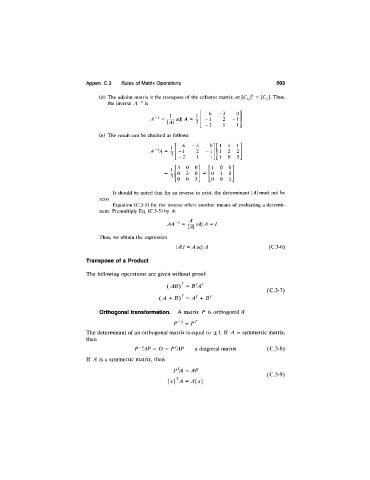Page 516 - Thomson, William Tyrrell-Theory of Vibration with Applications-Taylor _ Francis (2010)
P. 516
Appen. C.3 Rules of Matrix Operations 503
j
o
i
d
e
a
n
t
r
i
a
t
m
T
(d) The adjoint matrix x is the transpose of the cofactor matrix, or [C^jV = [Cjj]. Thus,
h
the inverse is
6 -3 0
A-' = ± ^d iA = ^ - 1 2 - 1
- 2 1 1
(e) The result can be checked as follows:
6 - 3 O' '1 1 1
A^'A = ^ 1 2 - 1 1 2 2
2 1 1 1 0 3
0 O' '1 0 0'
3 0 = 0 1 0
0 3 0 0 1
It should be noted that for an inverse to exist, the determinant \A\ must not be
zero.
Equation (C.3-5) for the inverse offers another means of evaluating a determi
nant. Premultiply Eq. (C.3-5) by A:
A A ~ ' = adjyl = /
Thus, we obtain the expression
\A\I = ^ adj ^ (C.3-6)
Transpose of a Product
The following operations are given without proof:
( A B f = B W
(C .3 -7)
( A + B f = A ^ + B ^
Orthogonal transformation. A m atrix P is orthogonal if
p-\ ^ pT
The determ inant of an orthogonal m atrix is equal to + 1. If /I = sym m etric matrix,
then
P ' AP = D = P ^ A P a diagonal m atrix (C .3-8 )
If ^ is a sym m etric m atrix, then
P^A = A P
(C .3-9 )
{ x } ^ A = A [ x )

